Caribbean Baking for Beginners: Master Traditional Sweet Making Techniques

I still remember my hands shaking as I measured coconut for Jamaican drops. The fear of failing and disappointing my grandmother was huge! That’s why I made this guide to traditional sweet making. It’s to turn that nervousness into excitement for your baking.
Many home bakers feel scared when trying island treats. They worry about the texture, if the ingredients are too exotic, or if they’ll waste expensive vanilla. I’ve been there too, and I know these worries disappear with the right help.
The magic of island baking recipes is their cultural mix. African spices, European methods, and local ingredients come together. They make desserts that tell stories through taste. From rum-soaked cakes to creamy coconut puddings, these treats bring island life to your table.
In this guide, I’ll share tropical baking techniques from island bakers for generations. We’ll make complex methods easy to follow. No more feeling scared – just the fun of making real Caribbean sweets with confidence!
Key Takeaways
- Overcome common anxieties about attempting traditional Caribbean recipes
- Understand the cultural fusion that makes island desserts unique
- Learn simplified techniques that make complex recipes approachable
- Discover the essential tropical ingredients and their substitutions
- Master the basic methods that form the foundation of Caribbean sweet making
- Build confidence through step-by-step guidance from an experienced baker
Sweet Paradise Awaits: Your Caribbean Baking Journey Begins
Step into the vibrant world of Caribbean sweets. Every bite tells a story of island heritage and sunshine! I’m excited to show you this colorful world of sweet-making that has captured my heart—and soon will capture yours too!
I still remember the first time I smelled a traditional black cake baking. The rich aroma of rum-soaked fruits and warm spices took me to the islands. That’s the magic of Caribbean desserts—they bring the vacation to you!
Many beginners feel intimidated by island cooking methods. Will my coconut bread be as good as Grandma’s? Can I really capture those authentic flavors? I had the same worries! But here’s my promise to you: with the right guidance, anyone can master these techniques.
What makes Caribbean baking special is how it combines practicality with celebration. These recipes were developed by resourceful island cooks. They made the most of local ingredients while creating something special for everyday enjoyment and festive occasions.
The beauty of tropical fruit desserts is their forgiving nature. There’s plenty of room for your personal touch while still honoring traditions. Can’t find fresh guava? Try passion fruit instead! No access to fresh coconut? The packaged stuff works wonderfully too!
Throughout this guide, I’ll break down complex methods into manageable steps. I’ll suggest ingredient substitutions when needed and share little tricks that make all the difference. We’ll explore everything from simple coconut drops to show-stopping rum cakes.
Caribbean baking is all about balance—sweet but not too sweet, rich but not heavy, complex yet simple. It’s about letting quality ingredients shine through thoughtful preparation.
| Caribbean Baking Element | What Makes It Special | Beginner-Friendly Tip | Common Example |
|---|---|---|---|
| Tropical Fruits | Natural sweetness and unique flavors | Start with banana or mango—they’re forgiving! | Banana bread with rum glaze |
| Spices | Warm, aromatic profiles | Begin with cinnamon and nutmeg before exploring more | Spiced sweet potato pudding |
| Coconut | Versatility in many forms | Canned coconut milk works great for beginners | Coconut drops cookies |
| Rum/Spirits | Depth of flavor and preservation | Use extracts if you prefer alcohol-free options | Traditional black cake |
So preheat that oven, pull out your mixing bowls, and get ready for a delicious adventure through the islands! Your kitchen is about to become your personal Caribbean paradise, and I’ll be right here with you every step of the way.
Remember, Caribbean baking isn’t about perfection—it’s about joy, sharing, and celebrating the incredible flavors that make these island treats so beloved worldwide. Let’s dive in!
The Rich Heritage of Caribbean Sweet Making Traditions
When you eat a traditional Caribbean sweet, you taste history. It’s a mix of influences from around the world. Each island’s desserts tell a story of cultural exchange and creativity.
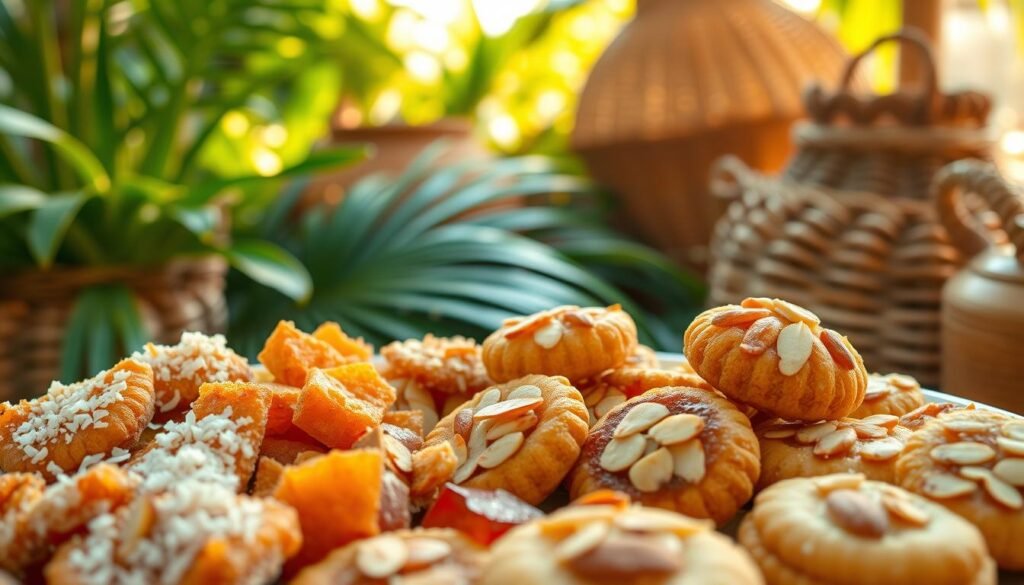
African Influences on Island Dessert Techniques
African cooking is key to many Caribbean sweets. Enslaved Africans brought their cooking skills to the Caribbean. These skills changed island food forever.
They introduced steaming puddings instead of baking. This made desserts like Jamaican cornmeal pudding moist. It’s perfect for the tropical heat.
African cooks also used root vegetables in sweets. Sweet potato pudding is a big hit across Jamaica. It shows how tubers can be sweet and delicious.
European Colonial Baking Adaptations
European colonizers brought new baking methods. They introduced wheat flour, butter, and sugar. These ingredients helped create the cakes and pastries we love today.
The British had a big impact, like in the Caribbean black cake. This fruit cake is a big deal at Christmas and weddings. It’s a mix of British and local flavors.
Spanish colonizers brought custard-based desserts. Cuban flan and Puerto Rican tembleque came from them. French and Dutch traditions also shaped Caribbean sweets.
Indigenous Taíno Sweet Preparations
The Taíno people knew how to use local ingredients. Their knowledge gives Caribbean sweets their unique taste. They used fruits, cassava, and natural sweeteners.
Cassava is a Taíno staple in desserts like cassava pone. They learned to make it safe to eat. It’s amazing how they passed on this knowledge.
The Taíno used tropical fruits and honey as sweeteners. These natural ingredients give Caribbean sweets their special flavor. It’s hard to find this taste elsewhere.
Modern Fusion: Traditional Meets Contemporary
Today, Caribbean baking is both traditional and modern. Bakers keep old recipes but also try new things. They use modern techniques and styles.
Traditional desserts like Trinidadian coconut drops are getting new twists. Bakers are making things like coconut-mango cheesecakes. They mix Caribbean flavors with international techniques.
Social media has helped share these new ideas. Caribbean bakers are getting famous worldwide. This mix of old and new keeps Caribbean sweets exciting.
| Cultural Influence | Key Techniques | Signature Ingredients | Notable Desserts |
|---|---|---|---|
| African | Steaming, hand-grating | Root vegetables, coconut | Sweet potato pudding, cassava pone |
| British | Fruit preservation, baking | Dried fruits, rum, spices | Black cake, rum cake |
| Spanish | Custard-making, caramelization | Eggs, milk, vanilla | Flan, tres leches cake |
| Indigenous Taíno | Cassava processing, fruit preservation | Cassava, tropical fruits, honey | Cassava bread, fruit preserves |
| Modern Fusion | Contemporary presentation, texture contrasts | Traditional flavors with global ingredients | Coconut-mango cheesecake, guava pastries |
Caribbean baking is full of inspiration for home bakers. It’s a way to connect with your roots or try new flavors. Traditional Caribbean sweets are a great place to start your baking journey.
Essential Caribbean Baking Ingredients Every Beginner Needs
Let’s explore the colorful world of Caribbean baking. It brings sunshine and flavors of the islands to your kitchen! Starting with Caribbean desserts, I was amazed by how right ingredients transport you to a beachside bakery. Don’t worry if some items seem new—I’ll help you with everything you need for authentic island treats!
Caribbean baking is special because of its unique ingredients. These reflect the region’s diverse cultural heritage. From African spices to European techniques and indigenous fruits, they create something special. Let’s stock your pantry with the essentials!
Tropical Fruits: Fresh, Dried, and Preserved
Tropical fruits are the heart and soul of Caribbean sweet making! Fresh mangoes, guavas, pineapples, and bananas add natural sweetness and moisture. I love using ripe bananas in Caribbean bread recipes—they add incredible flavor and keep everything moist!
Don’t limit yourself to fresh fruits though. Dried fruits are key for traditional treats like Jamaican black cake. I always keep prunes, raisins, currants, and dried cherries in my pantry. For authentic flavor, try soaking them in rum and wine—some bakers do this for months or even a year before baking!
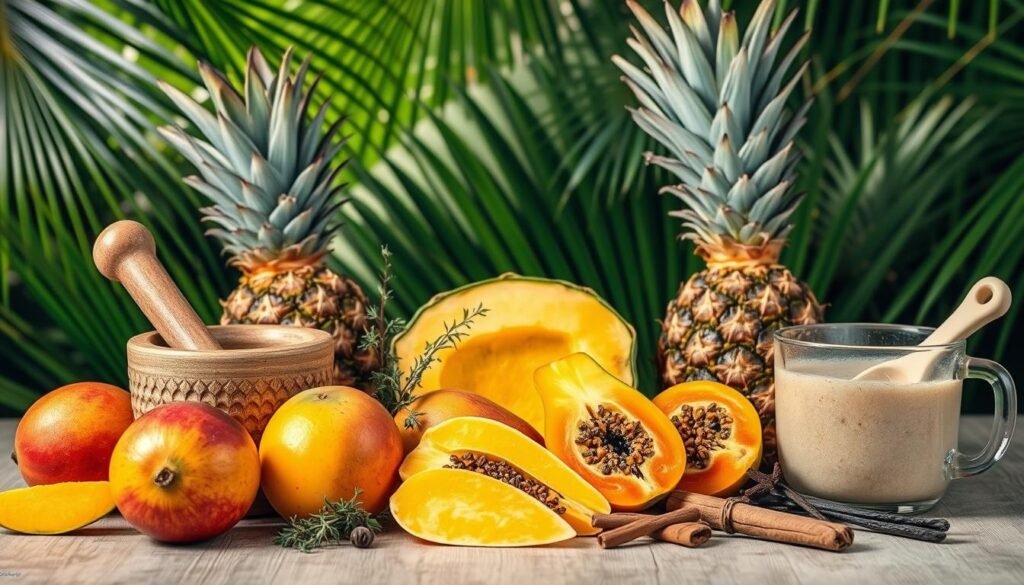
Preserved fruits add another dimension to your Caribbean baking arsenal. Guava paste, candied citrus peel, and fruit preserves are great for fillings and glazes. I once used guava paste in a coconut cake filling, and my friends couldn’t stop raving about it!
Coconut in All Its Forms: Milk, Oil, Flakes, and Fresh
If there’s one ingredient that defines Caribbean baking, it’s coconut! You’ll find it in nearly every traditional recipe, from breads to cakes to puddings. For your pantry, I recommend keeping several forms on hand for authentic coconut baking recipes.
Coconut milk and cream are absolute essentials. They add richness and tropical flavor to batters and fillings. I use them in everything from coconut milk desserts like tembleque (a Puerto Rican pudding) to cake batters that need moisture and flavor.
Coconut oil is another must-have. Unlike other oils, it adds a subtle coconut flavor that enhances your baked goods. It’s perfect for greasing pans when making traditional treats—the slight coconut aroma it leaves behind is divine!
Dried coconut flakes and shredded coconut are perfect for toppings, fillings, and mixing into batters. If you can find fresh coconuts, even better! Nothing beats the flavor of freshly grated coconut in authentic island desserts. I still remember the first time I cracked open a coconut for baking—what a game-changer!
Rum and Other Traditional Spirits in Baking
In Caribbean baking, rum isn’t just for drinking—it’s a crucial ingredient! Dark rum adds incredible depth to cakes and naturally preserves them. This is why traditional rum cake recipes can last for weeks or even months when properly stored.
Different islands favor different spirits. You might see recipes calling for white rum, brandy, sherry, or fruit liqueurs. Don’t skip these ingredients—they’re not just for flavor but also for authentic texture and preservation.
My tip for beginners: if you’re making a traditional rum cake, invest in a good-quality dark rum. The flavor really comes through in the final product! If you prefer not to use alcohol, you can substitute with rum extract and fruit juices, though the flavor profile will be slightly different.
Unique Spices and Flavorings
The spice cabinet is where Caribbean baking truly shines! Beyond the familiar cinnamon and nutmeg, you’ll want to explore some distinctive island flavorings that make these desserts so special.
Allspice (called “pimento” in Jamaica) is essential—it’s actually a single spice that tastes like a blend of cinnamon, nutmeg, and cloves. Ground ginger, cloves, star anise, and cardamom also feature prominently in many recipes.
Don’t forget vanilla! Caribbean bakers often use whole vanilla beans or pure extract for the best flavor. You’ll also encounter some unique extracts like almond, mixed essence (a blend of vanilla, almond, and other flavors), and rose water.
Brown sugar and molasses are staples for their rich flavor and moisture. Many traditional recipes also call for “browning”—a caramelized sugar syrup that adds color and a subtle bitter note to balance sweetness.
I remember feeling overwhelmed when I first saw a recipe calling for mixed essence and browning—ingredients I’d never heard of! But once I tracked them down at a Caribbean market, they transformed my baking. These unique flavors are what make island desserts so distinctive and delicious!
Traditional Caribbean Sweet Making Techniques Explained
Let me share the fascinating techniques behind authentic Caribbean desserts. They make these treats so uniquely delicious and hard to resist! When I first started exploring these methods, they seemed foreign to me. But I quickly discovered that Caribbean baking techniques are actually quite intuitive once you understand the reasoning behind them.
The beauty of Caribbean sweet making lies in how it adapts to the tropical environment. It honors diverse cultural influences. These techniques might take some practice, but they’re absolutely worth mastering!
The Art of Coconut Milk-Based Batters
Coconut milk is truly the heart and soul of Caribbean baking! Desserts made with coconut milk have an incredible moisture level. They have a tender crumb that’s hard to achieve with other ingredients. The natural sweetness and tropical flavor it imparts is simply unmatched.
When working with coconut milk in traditional Caribbean cakes, I always follow this key rule: balance is everything! The fat content in coconut milk needs to be properly balanced with your dry ingredients. Too much can make your cake greasy, while too little might leave it dry.
Here’s my tried-and-true technique: I add coconut milk gradually to my batters, stirring continuously. This prevents that dreaded curdling that can happen when coconut milk meets acidic ingredients like lime juice or buttermilk. For the creamiest Caribbean cream recipes, I sometimes reduce coconut milk by simmering it slowly. This creates a thick, luscious base for puddings and fillings.
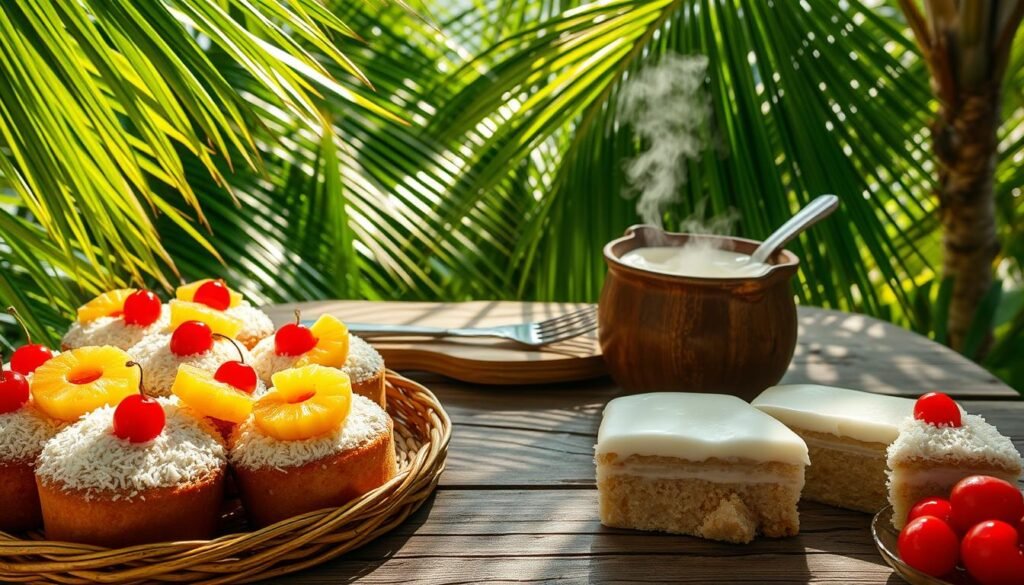
Steaming vs. Baking: When to Use Each Method
One of the biggest differences in Caribbean dessert making is knowing when to steam and when to bake! Steaming creates those signature pudding-like desserts with a dense, moist texture that’s absolutely divine. I use this method for treats like cornmeal pudding, cassava pone, and many traditional Caribbean steamed desserts.
I typically steam desserts one of two ways: either in a water bath in the oven (perfect for custards and flans) or using the traditional method of placing the baking pan over a pot of boiling water. The gentle, moist heat creates a texture that’s impossible to achieve through regular baking.
Baking, on the other hand, works best for cakes that need a lighter crumb or a crisp exterior. Many traditional Caribbean cakes, like the famous black cake, require a special low-and-slow baking approach. I bake these dense, fruit-filled cakes at just 250°F for about 2.5 hours, allowing the complex flavors to develop without burning.
| Technique | Best For | Texture Result | Example Desserts |
|---|---|---|---|
| Steaming | Pudding-like desserts | Dense, moist, custard-like | Cornmeal pudding, Cassava pone, Tembleque |
| Water Bath Baking | Custards and flans | Silky, smooth, tender | Flan, Quesillo, Coconut custard |
| Low-Temp Baking | Fruit-dense cakes | Rich, moist, complex | Black cake, Rum cake, Fruit cake |
| Standard Baking | Lighter cakes and pastries | Fluffy, airy, crisp edges | Coconut bread, Guava pastries, Sweet rolls |
Traditional Preservation and Candying Techniques
Island preservation techniques are fascinating and practical! Before refrigeration, Caribbean bakers developed ingenious methods to preserve fruits and create shelf-stable ingredients. These techniques don’t just extend shelf life—they actually enhance flavors!
My favorite preservation method is soaking dried fruits in rum and other spirits. For authentic black cake, I soak a mixture of prunes, raisins, and cherries in rum and cherry brandy for at least a month—though many Caribbean bakers maintain fruit soaking for years! The alcohol preserves the fruit while infusing it with incredible depth of flavor.
Candying is another essential technique I’ve mastered. I make candied citrus peels by boiling them in sugar syrup until they become translucent and sweet. These become amazing additions to cakes or stand-alone treats like coconut drops. The slow crystallization of sugar creates a natural preservative effect while transforming the texture completely.
Fruit pastes and jellies are also staples in the Caribbean baker’s arsenal. By cooking fruits with sugar until they reach a thick consistency, you create preserves that can last for months and serve as fillings for pastries and cakes. The concentration of sugar acts as a natural preservative while intensifying the fruit flavors.
Working with High Humidity: Island Baking Challenges
The biggest challenge I faced when learning Caribbean baking was dealing with humidity! High moisture in the air affects everything in baking—from how flour absorbs liquid to how meringues set and frostings hold up.
I’ve learned to make several adjustments when humidity is high. First, I reduce liquid slightly in recipes during rainy seasons—sometimes by as much as 2-3 tablespoons per cup. This compensates for the moisture your ingredients have already absorbed from the air.
Storage becomes critical too! I keep flour, sugar, and other dry ingredients in airtight containers with a few grains of rice at the bottom to absorb excess moisture. For tropical cake decorating, I’ve learned that traditional buttercream often fails in high humidity, so I rely on more stable options like cream cheese frosting or ganache.
Oven temperatures sometimes need adjustment too. I often increase the temperature by about 25°F and slightly reduce baking time to help desserts set properly before they can absorb too much ambient moisture. These small tweaks make a huge difference in the final results!
These traditional techniques might seem challenging at first, but they’re what give Caribbean desserts their unique character and irresistible appeal. With a little practice, you’ll be creating authentic island treats that transport you straight to the Caribbean with every bite!
Regional Sweet Specialties Across the Islands
Every Caribbean island has its own sweet treats. These desserts tell stories of cultural heritage through flavor. Exploring these traditions is a joy!
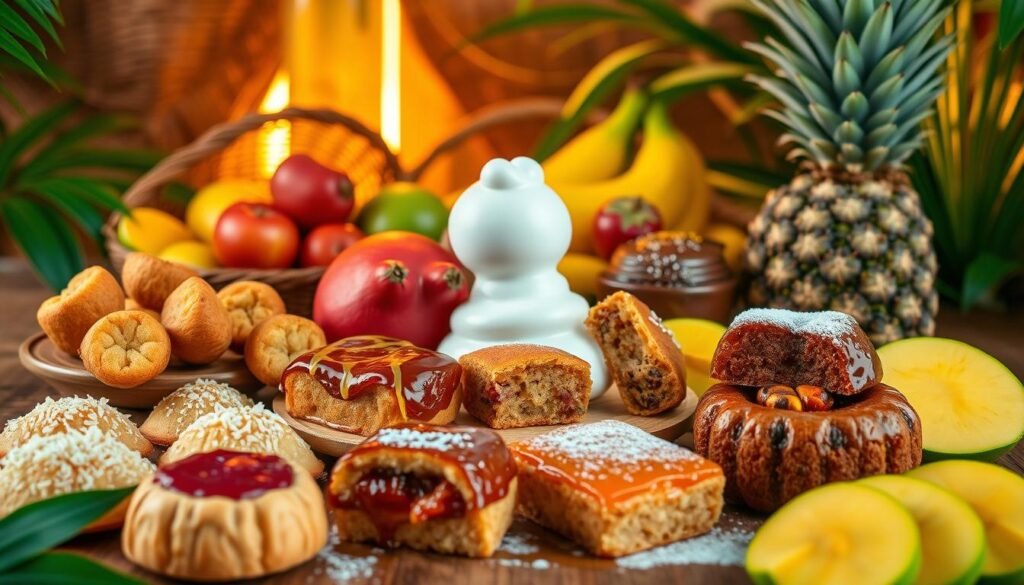
Jamaican Classics: Rum Cake, Gizzada, and Sweet Potato Pudding
Jamaica’s desserts are bold and flavorful. The Jamaican rum cake is a must-try. It’s dense and moist, with a kick from dark rum.
Gizzadas are coconut tarts with a sweet coconut filling. They’re spiced with ginger and nutmeg. My gizzada recipe uses fresh coconut and brown sugar.
Jamaican sweet potato pudding is comfort food. It combines sweet potatoes, warm spices, and coconut milk. It’s traditionally baked over coals for a smoky flavor.
Cuban Delights: Tres Leches, Flan, and Arroz con Leche
Cuban desserts are influenced by Spain. The tres leches cake is moist but not soggy. It’s soaked in three types of milk.
The perfect flan recipe has a silky custard and a golden caramel top. It’s made with patience and uses both condensed and evaporated milk.
Arroz con leche is a comforting rice pudding. It’s made with rice, milk, cinnamon, and citrus zest. You can find more Cuban pastries and sweet traditions to try.
Puerto Rican Favorites: Tembleque, Quesito, and Mallorca
Puerto Rican desserts blend Spanish techniques with tropical ingredients. Tembleque is a coconut pudding that “trembles” when shaken. My tembleque recipe uses coconut milk, sugar, cornstarch, and cinnamon.
Quesito is a flaky pastry filled with sweetened cream cheese. It’s brushed with sugar glaze. It’s perfect with strong coffee.
Mallorca is a soft, spiral sweet bread. It’s eggy and buttery, with a brioche-like texture. It’s often served with ham and cheese for a sweet-savory treat.
Trinidadian Treats: Coconut Drops, Kurma, and Black Cake
Trinidad and Tobago has diverse desserts. Coconut drops are chunks of coconut cooked with brown sugar. They’re addictive!
Kurma is a crispy cookie stick flavored with ginger and cinnamon. It’s glazed with sweet coating. It’s great for dunking in tea or coffee.
The famous black cake is a highlight of Trinidad’s desserts. It’s a dense cake soaked in rum and wine for months. It’s dark, rich, and complex, enjoyed at Christmas and weddings.
There are many more specialties to discover. This is just the start of your sweet Caribbean journey! You’ll see how coconut, tropical fruits, and spices tie the islands together, yet each has its own unique desserts.
15 Must-Try Caribbean Dessert Recipes for Beginners
Caribbean baking is magical, and these 15 recipes show it. They’re easy to make and full of island flavors. Each one is simple but still captures the true taste of the Caribbean.
Easy Jamaican Coconut Drops
These treats started my Caribbean baking journey. Coconut drops are a favorite for beginners. They’re easy to make and always a hit!
To make coconut drops recipe, you need 2 cups of fresh coconut, 1 cup of brown sugar, 1 teaspoon of ginger, ½ teaspoon of vanilla, and a pinch of salt. Mix everything well, then drop spoonfuls on a baking sheet. Bake at 325°F for 15-20 minutes until golden.
They come out crispy on the outside and chewy inside. Perfect for fresh coconut flavor. Friends love them!
Simple Cuban Tres Leches Cake
This cake is easy, despite its fancy name. My version is simple but impressive. It’s a great island cake recipe for beginners.
Start with a vanilla sponge cake. You can even use a box mix. The magic happens when you soak it in three milks: evaporated, sweetened condensed, and whole milk with rum.

Poke holes in the cake to soak it well. Let it sit overnight in the fridge. Top with whipped cream and cinnamon before serving. It’s moist and fluffy!
Beginner-Friendly Puerto Rican Tembleque
Looking for a no-bake option? Try Tembleque! It’s a coconut pudding that’s easy to make. It needs just four ingredients and sets up perfectly every time.
In a saucepan, mix 2 cans of coconut milk, ⅔ cup sugar, ½ cup cornstarch, and a pinch of salt. Whisk constantly until thickened, about 5-7 minutes. Pour into a mold or ramekins and chill for 3-4 hours.
Dust with cinnamon before serving. It’s silky and coconut-flavored. Refreshing after a spicy meal. Friends always ask for more!
Traditional Barbadian Sweet Bread
Bread-making is easy with this coconut-studded loaf. It’s forgiving for beginners. The dough is rich with butter and eggs.
Mix 4 cups of flour, 1 cup of sugar, 2 teaspoons of baking powder, and a pinch of salt. Add ½ cup of cold butter, 1 cup of grated coconut, 1 egg, 1 teaspoon of vanilla, and enough milk for a soft dough. Top with a sweet glaze made from sugar, water, and almond extract.
This sweet bread is great with tea or coffee. It stays fresh for days. A perfect introduction to Caribbean breads.
Other beginner-friendly treats include Jamaican Banana Bread, Trinidadian Cassava Pone, and sweet potato desserts like Jamaican Sweet Potato Pudding. For fruit lovers, try Easy Guava Pastries. They’re impressive with little effort!
Don’t miss out on plantain desserts like Caramelized Sweet Plantains. They’re quick and authentic. Just fry ripe plantains in butter and sprinkle with cinnamon sugar.
| Recipe | Difficulty Level | Prep Time | Key Ingredients | Special Equipment |
|---|---|---|---|---|
| Jamaican Coconut Drops | Very Easy | 15 minutes | Fresh coconut, brown sugar, ginger | Baking sheet |
| Cuban Tres Leches Cake | Easy | 30 minutes | Vanilla cake, three milks, rum | Deep cake pan |
| Puerto Rican Tembleque | Easy | 10 minutes | Coconut milk, cornstarch, sugar | Pudding mold |
| Barbadian Sweet Bread | Moderate | 45 minutes | Flour, coconut, butter, sugar | Loaf pan |
| Sweet Potato Pudding | Moderate | 30 minutes | Sweet potatoes, coconut milk, spices | Baking dish |
I’ve made these recipes easy without losing flavor. You’ll build confidence with each bake. Caribbean baking is about enjoying the process and sharing with loved ones. Which recipe will you try first?
Mastering Caribbean Baking Equipment and Techniques
Ready to take your Caribbean sweet-making to the next level? The right equipment and techniques make all the difference! When I first started exploring these delicious island pie recipes and treats, I quickly discovered that having the proper tools wasn’t just helpful—it was essential for authentic results!
Think of your kitchen tools as your baking partners. With the right equipment, even complex Caribbean cookie recipes become manageable for beginners. Let me walk you through the essentials that will transform your tropical baking adventures!
Traditional vs. Modern Equipment Choices
Caribbean grandmothers created amazing desserts with simple tools—cast iron pots, wooden spoons, and manual graters. These traditional implements still produce the most authentic results, but they require significant elbow grease!
I’ve found that balancing traditional and modern equipment gives me the best of both worlds. For instance, when making Caribbean tart recipes, I use:
| Traditional Tool | Modern Alternative | Best Used For |
|---|---|---|
| Coconut grater | Food processor | Preparing fresh coconut |
| Mortar and pestle | Spice grinder | Crushing spices for black cake |
| Hand whisk | Stand mixer | Whipping egg whites for meringues |
| Clay pot | Dutch oven | Slow-cooking puddings |
Don’t feel pressured to invest in everything at once! Start with versatile pieces that work for multiple Caribbean bakery recipes. A good food processor, for example, can replace several traditional tools while saving you hours of manual labor.

Working with Steamer Pots and Dutch Ovens
Steaming is a cornerstone technique in Caribbean dessert-making! Many traditional puddings and cakes rely on gentle, moist heat rather than dry oven baking. I use a large pot with a steamer basket for classics like Jamaican cornmeal pudding.
Here’s my simple steaming setup that works perfectly:
1. Fill a large pot with about 2 inches of water
2. Place a heat-safe trivet or small ramekins in the bottom
3. Set your baking dish on top (wrapped in foil if needed)
4. Cover tightly and maintain a gentle simmer
Dutch ovens are another must-have for serious Caribbean bakers. Their heavy bottoms prevent scorching when making caramel or tropical dessert sauces. I use mine for everything from coconut drops to baked puddings!
The magic of Dutch ovens lies in their versatility—they transition seamlessly from stovetop to oven. This is perfect for recipes that start with a caramelization step before baking, like many traditional Caribbean desserts.
Essential Tools for Coconut and Tropical Fruit Prep
Working with fresh tropical fruits requires some specialized tools. Trust me, trying to crack a coconut with a regular kitchen knife is a recipe for disaster (and possibly a trip to the emergency room)!
For coconut preparation, invest in:
• A sturdy coconut opener or heavy cleaver
• A dedicated coconut grater (if you’ll use fresh coconut often)
• A fine mesh strainer for making fresh coconut milk
When preparing other tropical fruits for your island pie recipes, these tools make life easier:
• A sharp paring knife for peeling and seeding mangoes
• A good quality zester for citrus fruits
• A melon baller for papaya and other soft fruits
• Silicone spatulas for folding delicate tropical fruit batters
Don’t forget about measurement tools! Caribbean recipes often use different measurement systems depending on their origin. I keep both standard and metric measuring cups and spoons handy to avoid conversion headaches.
With these essential tools in your kitchen arsenal, you’ll be well-equipped to tackle any Caribbean bakery recipes with confidence. Remember, quality tools are an investment in your baking success—they’ll make the process more enjoyable and your results more authentic!
Understanding Caribbean Baking Science
Ever wondered why Caribbean desserts taste different outside the islands? It’s all about tropical baking science! Learning these basics helps fix recipe issues and adapt to your kitchen. Mastering a few key concepts can make your Caribbean baking truly authentic!
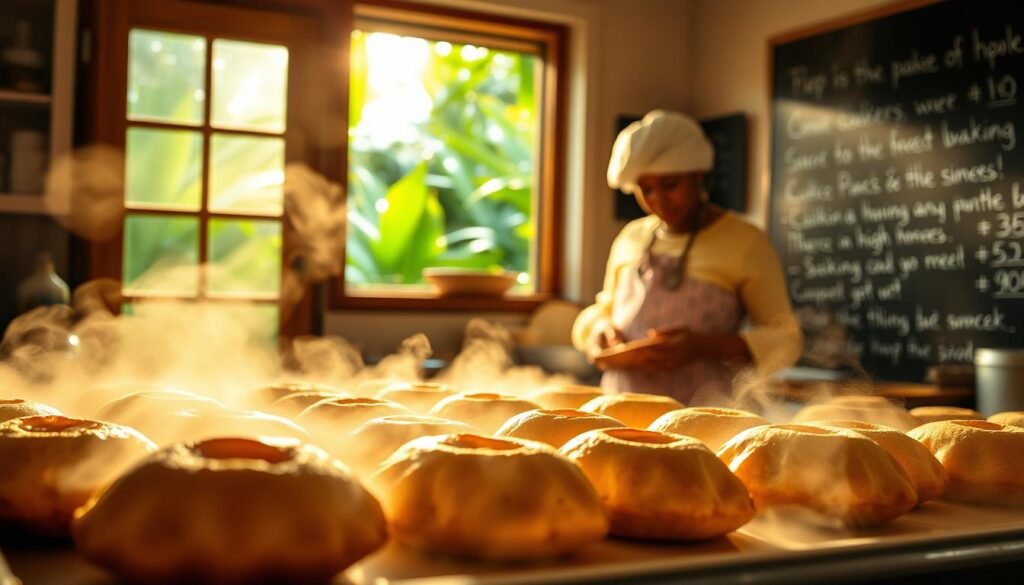
How Humidity Affects Your Baking Results
Humidity is a big deal in Caribbean baking. Most island recipes were made in very humid places, 70-90% humidity! This changes how flour absorbs moisture and how treats turn out.
In dry places, you might need more liquid in recipes. Adding an extra tablespoon or two can help, like with guava pastries. The dough needs more moisture for the right texture.
But in humid kitchens, you might need less liquid or bake longer. This is key for caribbean breakfast pastries, which can get soggy if not right.
Keep ingredients like flour and sugar in airtight containers. This helps keep your baking consistent, no matter the humidity. It’s a simple trick that makes a big difference!
Altitude Adjustments for Island-Style Recipes
Caribbean islands have different elevations, which affects baking. At high altitudes, cakes rise too fast and then fall. This is bad for delicate desserts!
At high altitudes (above 3,000 feet), you need to make some changes:
- Increase oven temperature by 15-25°F
- Reduce leavening agents (baking powder/soda) by 1/4 to 1/2
- Add 1-2 tablespoons of extra liquid per cup of flour
- Increase flour by 1-2 tablespoons per cup
These changes are crucial for rum cakes and black cake. Black cake should be soft, like pudding. It’s best baked three days before serving to let flavors blend.
When making Caribbean ice cream or sorbet recipes, altitude also affects freezing times. You might need to freeze them a bit longer at higher elevations.
Working with Natural Sweeteners and Sugar Alternatives
Caribbean recipes often use natural sweeteners like cane sugar and molasses. These add moisture and acidity, changing how batters rise and set.
Trying natural sweeteners in mango desserts creates deeper flavors. Remember, they’re less sweet but richer in taste.
Rum is special in Caribbean baking. It’s not just for flavor; it preserves and tenderizes. It carries flavors that water can’t, making fruits in desserts taste intense.
| Sweetener Type | Effect on Moisture | Effect on Texture | Best Used In |
|---|---|---|---|
| Raw Cane Sugar | Slightly increases | Creates chewier texture | Cookies, breakfast pastries |
| Molasses | Significantly increases | Makes denser, moister results | Black cake, gingerbread |
| Coconut Sugar | Neutral | Similar to brown sugar | Lighter cakes, ice cream bases |
| Fruit Purees | Greatly increases | Creates softer, more tender crumb | Mango desserts, sorbets |
Learning these scientific basics lets you adapt traditional recipes for your kitchen. Once you understand these concepts, you can fix almost any Caribbean recipe problem!
For example, guava pastries need special handling because of guava paste’s acidity. Knowing this lets you adjust other ingredients for that perfect flaky texture.
Science might seem hard, but it’s just about understanding why things work. Once you get it, you can make authentic Caribbean treats anywhere!
Troubleshooting Common Caribbean Baking Challenges
Caribbean baking has its own set of challenges. Even experienced bakers face problems. But don’t worry, I’ve got solutions for you! After years of making traditional sweets, I’ve solved most issues. Let’s fix these common problems so your treats are perfect every time!
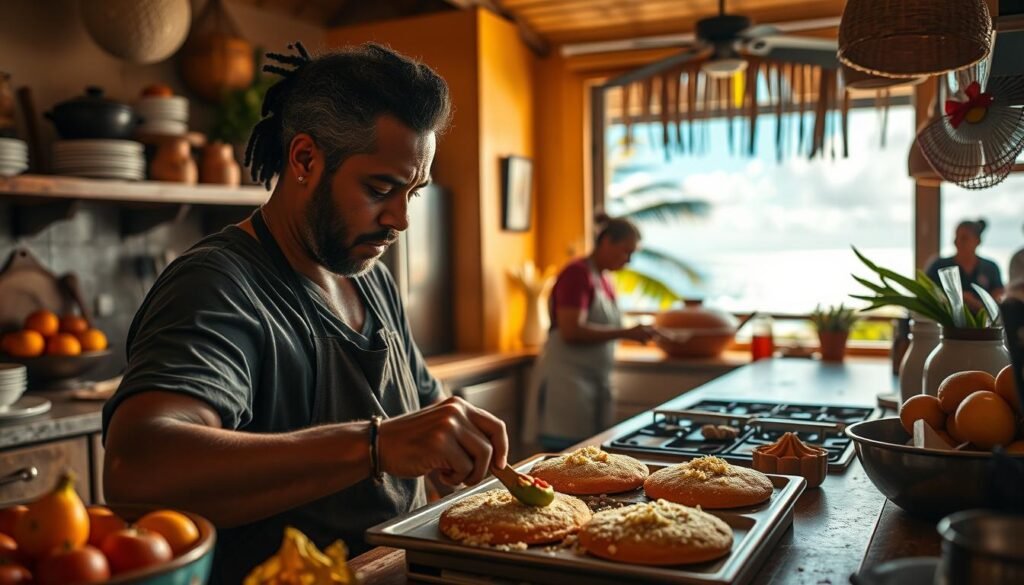
Preventing Coconut Milk from Curdling
Curdled coconut milk ruins a beautiful Caribbean custard. It happens when coconut milk proteins react with acidic ingredients or heat. I learned this the hard way while making tembleque and other coconut desserts.
To avoid curdling, warm coconut milk to room temperature before using. This simple step helps a lot! When making coconut flan, add coconut milk slowly while whisking continuously.
Another trick is to mix acidic ingredients like lime juice or passion fruit separately from coconut milk. If your recipe has both, add a pinch of baking soda to balance the acidity.
Quick fix: If coconut milk starts to curdle, stop heat and whisk hard. Adding a teaspoon of cornstarch mixed with water can save the mixture!
Achieving Perfect Texture in Steamed Desserts
Steamed Caribbean desserts like cassava pone can be tricky. Too much moisture makes them soggy, while too little makes them dry. The key is consistent heat and humidity.
Pre-heat your steaming water before adding your dessert. This ensures even cooking. Keep the water simmering gently – too much agitation can mess up textures.
Don’t peek too often! Each time you lift the lid, you lose steam and lower the temperature. For puddings and cassava desserts, look for set edges with a slight jiggle in the center.
Texture troubleshooting tip: If your steamed dessert is too wet, a brief oven finish can help. Just 10-15 minutes at 300°F can set the texture without drying it out.
Balancing Sweetness with Tropical Fruit Acidity
Tropical fruits add amazing flavor but can upset the recipe’s balance. Passion fruit recipes are tricky because of the fruit’s varying tartness.
When using acidic fruits like passion fruit, taste as you go! You might need to adjust sugar or add a bit of baking soda. Letting fruit-based batters rest for 10-15 minutes before baking helps flavors meld.
For passion fruit recipes, mix the pulp with a bit of condensed milk before adding it to the batter. This pre-neutralizes some acidity while keeping that tropical flavor we love!
| Common Challenge | Possible Cause | Quick Solution | Prevention Tip |
|---|---|---|---|
| Burnt sugar syrup tastes bitter | Cooked too long | Add a splash of hot water to dilute | Remove from heat as soon as it darkens |
| Rum cake too boozy | Too much undiluted rum | Let sit overnight to mellow | Brush with diluted rum (1:1 with water) |
| Gummy texture in coconut desserts | Overworked batter | None (must prevent) | Mix just until ingredients are combined |
| Cassava pudding too dense | Too much cassava, not enough liquid | Serve with ice cream or sauce | Follow 2:1 ratio of grated cassava to liquid |
Other common issues include black cake crumbling (solution: use room temperature eggs and butter), soggy pastry bottoms (try dusting with flour before filling), and custards not setting (usually needs more egg yolks or longer cooking time).
With these tips, you’ll be ready for any Caribbean baking challenge! Remember, even traditional recipes might need tweaks based on your ingredients and kitchen. Trust your instincts and don’t be afraid to try new things!
Building Your Caribbean Baking Pantry on a Budget
Successful Caribbean baking at home isn’t about having every exotic ingredient. It’s about knowing which essentials to prioritize on a budget! When I first started exploring traditional Caribbean sweets, I felt overwhelmed by long ingredient lists. But I learned that Caribbean cooking is all about being resourceful, making it perfect for budget-conscious bakers!
With smart shopping and substitutions, you can make authentic island flavors without spending a lot. Let me show you how to build your Caribbean baking foundation affordably, one step at a time!
Essential Ingredients to Stock First
Start with these basic items that are key to many Caribbean confections:
First, get pantry staples like all-purpose flour, granulated sugar, and brown sugar. These are the base of most recipes. Add baking powder and salt to your list—they’re used in sweet breads and island tarts.
Next, focus on flavor builders. Vanilla extract is a must! Cinnamon and nutmeg are essential in Caribbean baking. If you can only get two spices, choose these!
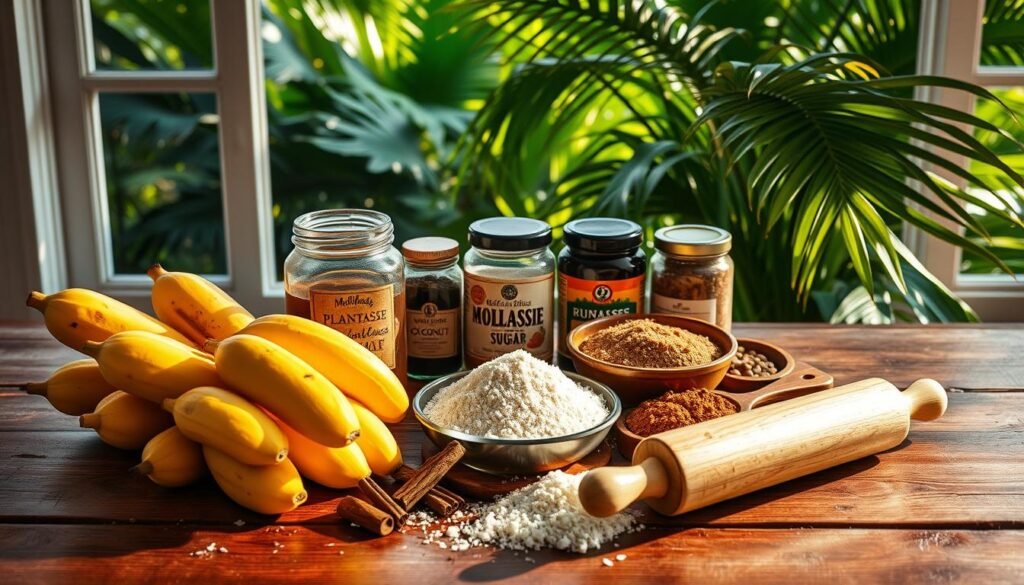
Don’t forget coconut milk—it’s key for authentic texture and flavor in many caribbean cream recipes. Dark rum is surprisingly affordable since it lasts forever. It adds a signature island flavor to cakes, cookies, and puddings.
With just these basics, you can make several classic treats. Start simple and build slowly. It’s better than trying to buy everything at once!
Where to Source Authentic Caribbean Baking Supplies
Finding authentic ingredients doesn’t mean high prices at specialty stores! Here’s where I find budget-friendly Caribbean baking supplies:
International grocery stores are great for tropical ingredients. Latin, African, and Asian markets often have better prices than mainstream stores.
Online retailers make Caribbean ingredients easy to find. While Amazon has many items, check smaller online Caribbean stores for better prices on specialty goods for island tart recipes and more.
If you live near a Caribbean community, small local stores have everything at authentic prices. These shops carry fresh ingredients perfect for tropical cake decorating and traditional baking.
Farmers markets in warmer areas often have tropical fruits and fresh coconuts at low prices. I’ve found amazing mangoes, papayas, and even sugarcane here!
Money-Saving Tips for Specialty Ingredients
Some Caribbean baking ingredients seem pricey, but these tips can help you save:
Buy whole spices instead of pre-ground. They last longer and taste better. I keep whole nutmeg, cinnamon sticks, and allspice berries in my pantry and grate them as needed for the freshest taste in my traditional Caribbean sweets.
Frozen tropical fruits are great for baking! They’re picked at peak ripeness, cost less than fresh, and reduce waste. I use them in rum cakes and fruit fillings.
Make your own extracts by infusing rum with vanilla beans or almond slivers. This is more economical and creates authentic flavors perfect for caribbean cream recipes.
For coconut, canned coconut milk works well in most recipes. Unsweetened coconut flakes can substitute for grated coconut in many cases, saving money and time.
When recipes call for specialty items like mixed essence or browning, look online for homemade alternatives. For example, you can make your own browning sauce by caramelizing sugar with water—a fraction of the cost of store-bought!
Start with simple recipes that use fewer specialty ingredients. As you get more comfortable with Caribbean baking, you’ll know which specialty items are worth the investment for your favorite Caribbean confections.
Remember, traditional island baking is about making the most of what you have. It’s about heart, flavor, and creativity! With these budget-friendly tips, you’ll be making delicious island treats in no time.
Seasonal Caribbean Baking: Celebrating with Traditional Sweets
Seasonal desserts in the Caribbean capture the spirit of celebrations. Island baking traditions follow holidays and seasons. Each sweet tells a story of cultural heritage and community joy.
Christmas and Holiday Baking Traditions
Christmas in the Caribbean is a time for baking. The star is the black cake, a rich, rum-soaked fruit cake. I start making mine months early, soaking fruits in rum and wine.
The kitchen fills with the smell of caramelized sugar and spices. This signals the holiday season has arrived! Each family guards their black cake recipe like treasure.
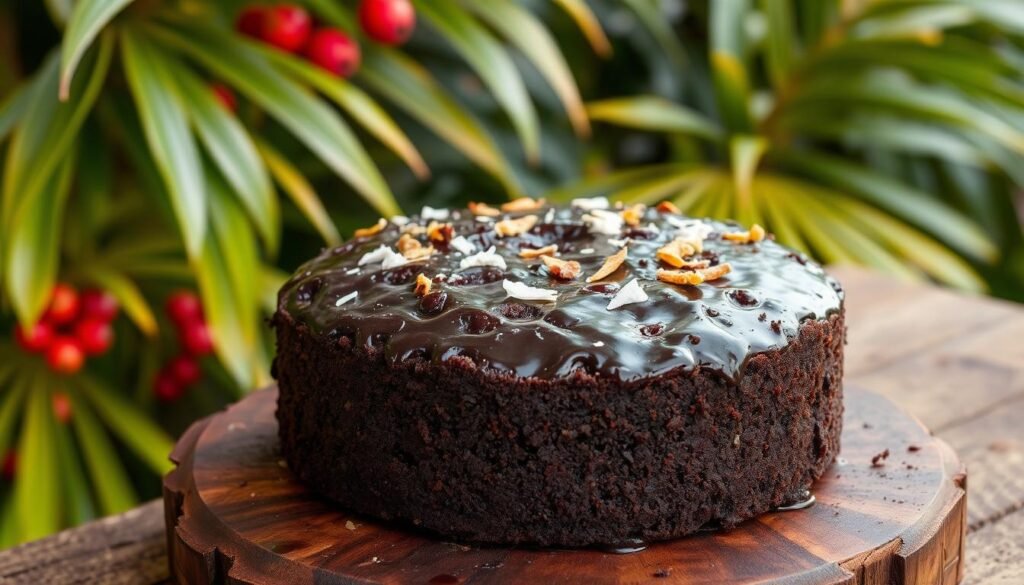
Caribbean wedding cakes are like black cakes but with almond paste and royal icing. Christmas black cakes are plain, letting rum flavors shine.
Each island has its holiday sweets. In Barbados, sweet bread is a must. Puerto Rico has arroz con dulce with cinnamon and coconut. Trinidad’s pastelles are sweet cornmeal parcels filled with fruits.
Carnival and Festival Sweet Treats
Carnival desserts are portable treats for dancing and celebration. Trinidad’s Carnival brings out colorful kurma, sugar cake, and toolum.
I make coconut ice in carnival colors. It’s sweet and creamy, perfect for sharing. Jamaica’s festival season features gizzadas and grater cakes, all coconut-based.
Festival sweets are made to withstand heat and humidity. They’re quick energy sources. You can find amazing Caribbean dessert recipes to make at home!
Harvest Season Fruit-Based Desserts
The Caribbean’s tropical climate brings a parade of fruits for desserts. Mango season brings mango fool, cheesecakes, and tarts.
Guava season brings fragrant pink fruit for pastes and jellies. Soursop season is a favorite, with its creamy ice cream.
Passion fruit, tamarind, and star apple each get their moment. These desserts connect Caribbean baking to island life’s bounty.
| Season/Celebration | Traditional Dessert | Main Ingredients | Island Origin | Special Techniques |
|---|---|---|---|---|
| Christmas | Black Cake | Rum-soaked fruits, burnt sugar, spices | Pan-Caribbean | Fruit soaking (months in advance) |
| Carnival | Sugar Cake | Fresh coconut, sugar, food coloring | Trinidad | Quick setting without baking |
| Harvest (Mango Season) | Mango Fool | Ripe mangoes, cream, sugar | Jamaica | Gentle folding to maintain texture |
| Weddings | Iced Black Cake | Black cake, almond paste, royal icing | Pan-Caribbean | Multi-layer icing and decorating |
| Easter | Coconut Drops | Fresh coconut, ginger, sugar | Barbados/Jamaica | Quick-drop cookie method |
By following these traditions, you’ll taste the full range of Caribbean flavors. Each sweet carries centuries of history and cultural influences.
Try making these treats even if you’re far from the Caribbean. They’ll bring island sunshine and celebration to your kitchen, no matter the weather!
Your Sweet Success Story Starts Here
You’re now ready to start your Caribbean baking adventure! I’m excited for you to make your first coconut drops or slice a rum-soaked cake. The journey into traditional sweet making is as rewarding as the treats!
Don’t worry if your first traditional Caribbean cakes aren’t perfect. My first black cake was heavy as a brick! Each try teaches you something new. Start with simple island baking recipes like coconut bread or banana fritters to build confidence.
The secret ingredient in Caribbean pastries isn’t listed on any recipe card – it’s patience! Many dishes need time for fruits to soak, flavors to blend, and skills to develop. Enjoy every step of this slower pace.
Try playing reggae or soca while you bake to set the mood! The rhythm makes rolling out dough for guava tarts more fun. When December comes, those Caribbean holiday desserts will bring tropical warmth to winter gatherings.
With each recipe you try, you’re not just making sweets – you’re connecting with generations of island bakers. Your hands are continuing their story, one delicious bite at a time.
So heat up that oven, crack open those coconuts, and let your sweet Caribbean journey begin!